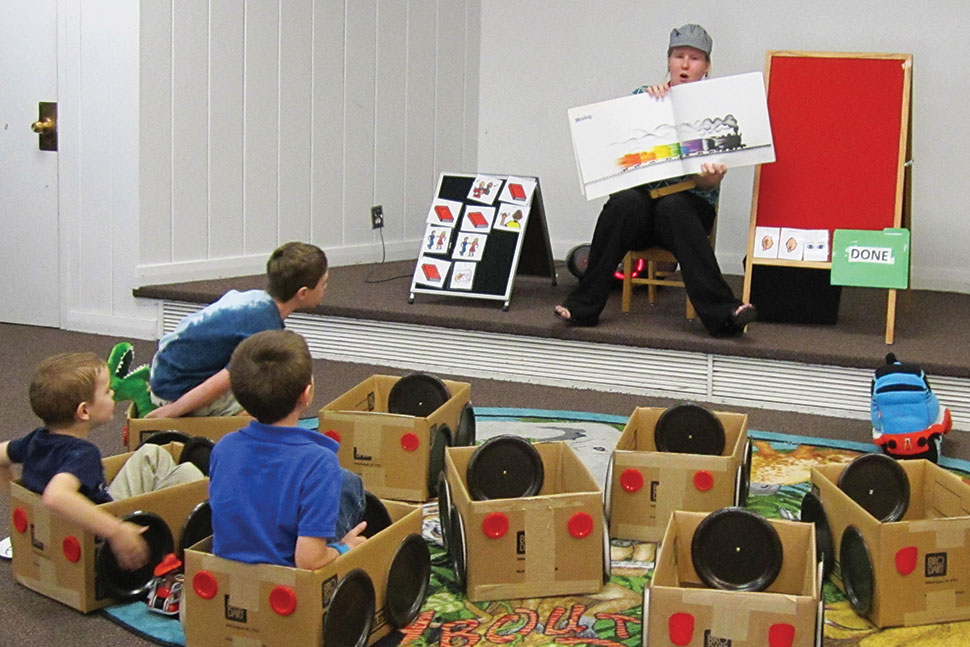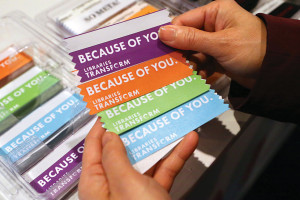
Librarian Carrie Rogers-Whitehead noticed there were always a couple of kids running around and making noise during one of her storytimes. And when they started up, the rest of the 2- and 3-year-olds followed suit. She decided to ask their mom what she could do to make storytime a more positive experience for her kids, but she didn’t expect the mother’s response.
“She began crying and got very upset. She said, ‘I’m so sorry. They have autism. We don’t go to the library very much because I don’t feel welcome,’” says Rogers-Whitehead.
And that was the beginning of the Salt Lake County (Utah) Library’s sensory storytime—a special program for children on the autism spectrum. Rather than exclude families that didn’t feel comfortable in a traditional library storytime, Rogers-Whitehead wanted to create a space for these kids and their parents.
“I realized there was a gap in our services, and there’s a need here. We have parents who aren’t going to the library because they’re afraid they won’t be welcome, so let’s change that,” she says.
Across the United States, the number of kids diagnosed with autism spectrum disorder is rising, from 1 in 80 kids in 2010 to 1 in 45 kids in 2015, according to the Centers for Disease Control and Prevention. In response, parents and librarians are working together through programming and awareness to help make the library a space where children on the autism spectrum are welcome.
As a parent of a child with autism, Shannon Andreson knows the isolation families can experience. Although her son loves books, she says they rarely visited a library when he was young.
“I read to him all the time, and I love libraries. But when he was little, I literally broke out in a cold sweat when I thought about taking him to a storytime because I didn’t know how he would behave,” says Andreson.
These days, Andreson is executive director of the Center for Engaging Autism in Minnetonka, Minnesota, and is partnering with area libraries to create experiences for kids on the autism spectrum. She has put together research on the autistic brain with cutting-edge practices for improving literacy in children on the spectrum and uses it to help train librarians to create programming for families and children.
“We’ve found that even in very small children you can start pinpointing literacy tools that work at a very young age, and the impact is twofold,” says Andreson. “One, you address their deficits in literacy, as children on the spectrum often struggle in language arts. But the tools address deficits in the child’s language development as well.”
Understanding why a traditional storytime is hard for children on the autism spectrum—and what librarians can do to change that—starts with a basic understanding of what autism is, she says.
Enjoying a program looks totally different for kids with autism.
–Renee Grassi, youth department director at Glen Ellyn (Ill.) Public Library
“Autism is a brain disorder. Their brains work differently. There are lots of reasons for this, but one main reason is that kids on the spectrum process information in a different part of the brain than a typical child does. So the information needs to be presented differently in order for kids to be engaged,” Andreson says.
She says many librarians are already doing this—varying the ways they present a book or an idea through songs, finger plays, and movement. But a sensory storytime takes that idea a bit further, giving kids more ways to process information.
For example, Andreson says, most kids on the spectrum are very concrete thinkers, so when telling a story, it helps to have a tangible way to understand it, rather than just the pages of a book. During a sensory storytime, a librarian might use figures on a table or shapes on a felt board to tell the story, rather than just turning pages and showing pictures.
In addition to processing information differently, most children on the autism spectrum struggle with some sort of sensory issue, says Andreson. Something as simple as fluorescent lighting can feel like a loud humming or a flashing light.
“Some kids develop a really great coping mechanism, like covering their ears to filter out the noise,” she says. “Their brain isn’t doing it for them, so they have to do it physically.”
These sensory issues can make it look as though children aren’t engaged, but actually, they’re trying their best to shut out other sensory input to focus on what’s going on.
“My son will turn his back to you,” says Andreson. “It doesn’t mean he isn’t listening. The kid listens and remembers more than I could ever hope to. But if he wants to hear what the person is saying, he turns his back so he can focus.”
Librarian Renee Grassi, youth department director at Glen Ellyn (Ill.) Public Library, has noticed these kinds of behaviors in the five years since she created a sensory storytime program at Deerfield (Ill.) Public Library.
“Enjoying a program looks totally different for kids with autism,” Grassi says. “They might not always be looking at the librarian or be repeating the refrain, but it doesn’t mean they’re not taking the information in. Maybe they’re walking around the room, but it doesn’t mean they’re not listening.”
Another common trait of children on the autism spectrum is their need to know what’s coming and to have a way to transition from one activity to the next. In a typical storytime, a librarian may move from book to song to craft and expect children to follow along, but for children with autism, that can be more of a challenge.
To help kids make those shifts, Grassi created a large visual schedule with pictures of each task. She even created a small version for kids to hold in their hands, allowing them to physically move each activity to the back as it was completed. In addition, she tries to keep a consistent structure, with the same hello and good-bye song each week.
Equally important are flexibility and tailoring a program to the kids who attend.
“You will see some children with autism who are highly verbal and other kids who are completely nonverbal and have to rely on technology or supports to communicate,” says Grassi. “There’s a quote that says, ‘If you know one person with autism, you know one person with autism.’ It’s a spectrum disorder, so each person is different in what they need.”


